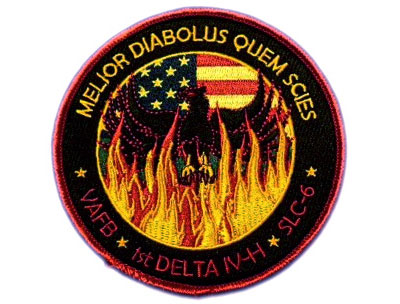Better the devil you know…by Dwayne Day
|
| All of these symbols on the patch hint that this is the fifteenth launch of a KH-11 type electro-optical reconnaissance satellite. |
The patch for NRO Launch 49 depicts a phoenix rising from the flames. The patch also features fourteen stars, including one being carried in the bird’s beak. There also appears to be a fifteenth star obscured by the bird’s wing. There’s a long tradition in such patches for the stars to symbolize the number of payloads launched. Fourteen stars just happens to be the number of KH-11 type electro-optical satellites successfully launched by the United States over the years—including the one being carried into orbit by this bird. A fifteenth launch—the one obscured star—ended in failure.
The Latin words “melior diabolus quem scies” are inscribed on the patch. This roughly translates to mean “the devil you know,” as in the phrase “better the devil you know than the devil you don’t know.”
All of these symbols hint that this is the fifteenth launch of a KH-11 type electro-optical reconnaissance satellite. The KH-11 and its descendents have been in service since 1976, and the program was scheduled for replacement by a new series of satellites as part of the Future Imagery Architecture, or FIA. But FIA ran into problems and was canceled. (See “Gum in the keyhole”, The Space Review, June 22, 2009).
As FIA was falling apart, according to news reports, the National Reconnaissance Office, which builds and operates America’s spy satellites, decided to assemble one last KH-11 from spare parts. Thus, this spacecraft is rising from the flames of FIA. And although the KH-11, or whatever it is called these days by The People Who Don’t Talk About Such Things, is an old devil, at least it’s a known devil.
Acknowledgment: Thanks to GW.
